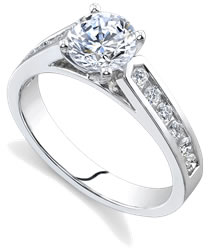Diamond Clarity

View our diamonds here. |
Diamond Clarity: A Clue into a Diamond’s Value
What does diamond clarity have to do with a diamond? A lot. There are many who believe that simply owning a diamond places them in an elite club. The truth of the matter is not all diamonds are created equally. Diamond clarity is one of the four determining factors of the value of a diamond. So, understanding diamond clarity can mean the difference in buying a valuable diamond and one that is less than valuable.
A Flaw in Your Diamond?
What is diamond clarity and why should you care about it before making a diamond purchase? Diamond clarity is a bit of history about a diamond, built right into the stone. A diamond has its beginning in the deep of the earth. From that moment on its surface succumbs to its environment, yielding in most cases, variances in flaws. The flaws, referred to as inclusions, determine the value of a diamond.
There are flawless diamonds, but these are very rare. The word “flaw” when associated with a diamond has a negative connotation for most consumers. However, in the diamond industry flaws are a reality. The majority of diamonds contain a flaw. Of all diamonds that are mined, only 20% of them are suitable for use as a gemstone.
Determining the Value of a Diamond
Diamond clarity is not something that you can determine with the naked eye. A gemological microscope looks similar to a microscope you might find in a biology lab. There is other equipment available for a gemologist to use to determine diamond clarity but a gemological microscope is considered the most accurate. Using a grading scale established by the Gemological Institute of America’s (GIA), a gemologist considers a diamond flawless, imperfect, or somewhere in between.
A flawless (FL) diamond is perfectly clear whether you view it under a microscope with 10x magnification or using the naked eye. A one-carat flawless diamond can cost upwards of $5,000. If a gem is considered to have internally flawless (IF) diamond clarity it may contain external flaws but it should have no internal flaws. In the middle of the road are very, very slightly included (VVS) and very slightly included (VS) diamond clarity grades. These grades of diamonds have only a slight flaw but they are not easily detectable with 10x magnification.
A diamond with slightly imperfect (SI) diamond clarity typically has a few flaws that are usually only detectable with 10x magnification. A diamond with this grade of diamond clarity is considered a good buy. Using 10x magnification or not, a diamond with imperfect (I) diamond clarity has several inclusions.
Shopping for Valuable Diamonds
You don’t have to be a gemologist to determine diamond clarity, but it does take some experience and skill. You can purchase a hand loupe with a 10x magnification and use it when you shop for diamonds; however, this equipment is not as accurate as a gemological microscope. When shopping for diamonds you will discover that many jewelers have a gemological microscope on the premises and are more than happy to allow you to use the equipment to view a diamond. You may even impress them with your knowledge of diamond clarity.
Related Articles
|